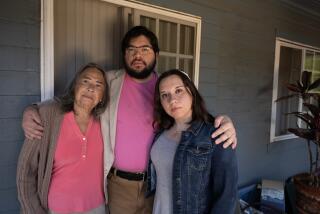Carson Takes Brushes to Graffiti : Community action: It took just one fed up neighbor to help mobilize residents and the city government for the crusade.
For Roxanne Greene, the last straw was discovering the scrawlings of a graffiti “tagger” about a year ago on a telephone pole in front of her house near Carson.
It wasn’t the first time the unincorporated neighborhood had been defaced by gang members or taggers. But Greene, who has lived on 228th Street for more than five years, was fed up. The incident prompted her to launch a crusade to wipe out graffiti on her block and in surrounding areas.
“That was the breaking point,” Greene recalled. “It’s not as dramatic as being burglarized. But you feel violated, like they’ve invaded your neighborhood.”
Today, what began as her single-handed effort to paint over graffiti has mushroomed into Neighbors Against Graffiti, or NAG, a group Greene formed with assistance from the Los Angeles County Sheriff’s Department.
In July, the group held a “Graffiti Removal Day” in Carson and surrounding areas that attracted more than 200 participants. The event was so successful that the city is helping to sponsor another “paint-out” on Oct. 12.
“We ran out of paint--200 gallons--and places to paint,” Greene said. The group was split up and assigned to 10 problem areas, but people who took part in the event “were even stopping their cars on the way and painting things over,” she said.
Although Greene and the Sheriff’s Department acknowledge that a significant amount of graffiti reappeared after the paint-out, the program succeeded in educating residents to take responsibility for removing it. Dealing with graffiti is an ongoing battle, but Greene said her group has more people and supplies than the vandals.
“We’re all in this together,” she said.
Greene, a slender woman who smiles easily, said prior attempts at organizing her neighbors were unsuccessful. Her working-class neighborhood of single-family homes and condominiums had been increasingly targeted by taggers and gangs. In the largely industrial surrounding area and other sections of Carson, graffiti marred warehouses, fences--even churches.
“Nothing is sacred anymore,” Greene said. “You would think at least churches would be safe.”
Residents, though, feared retaliation from any of several active gangs if they attempted to clean up the community, Greene said.
So, for about six months after the telephone pole incident, Greene took it upon herself to do away with the area’s graffiti. She would awaken early on Sundays, don a painter’s cap and old clothes, grab a brush and a gallon of paint, and wipe over what she calls “chicken scratch” scrawled around her neighborhood.
“I was just fed up with looking at it,” she said.
Greene, 28, said she feared little in the way of gang retaliation because she always notified sheriff’s deputies of her whereabouts whenever she went on paint-outs. Besides, being a native of Detroit, Greene said, “I think I’m a little more street smart than most.”
Despite her efforts, Greene had little lasting success until she approached community relations deputies Ralph Gama and Joyce Cagaanan at the department’s Carson substation. Deputies enlisted the aid of Neighborhood Watch block captains, who now form the core of NAG’s membership.
The paint-out program, Gama said, is designed to educate residents about the best methods of dealing with graffiti. Several other cities across the South Bay have conducted or are planning paint-outs. Lomita, for example, is helping to sponsor a Graffiti Removal Day on Sept. 28.
Much of the graffiti in Carson is the result of a combination of gang members and taggers looking for attention, Gama said. Sometimes, when rival gangs have crossed out each other’s monikers, he said, gang confrontations aren’t too far behind. Mostly, though, the graffiti is an attempt at free expression, Gama said.
“I would like to see that expression channeled into more positive activities,” he said. Gang members and taggers “want attention, perhaps because their needs aren’t being met at home. That’s why I would like to see us look inward, at the home. That’s where it all starts.”
The efforts of Greene and the deputies have also caught the interest of Carson officials. The city pitched in 100 gallons of paint, as did Standard Brands, a local paint store, for the July paint out. Similar contributions are expected for October’s program.
“I never thought it would be this big,” Greene said.
City Administrator Larry Olson said Carson spends up to $500,000 annually for graffiti removal, which includes labor, paint and other materials. “We consider it a very serious and costly problem,” Olson said.
He praised Greene’s efforts. Two weeks ago, the City Council issued a proclamation honoring Greene and NAG and presented group members with certificates.
“I am very thrilled at the work she is doing and the help from the community,” Olson said. “I think it’s very commendable.”
Gama said the paint-out program is part of the department’s effort at community-oriented policing, in which law enforcement authorities work closely with community members. “We can’t do it alone and neither can they,” Gama said.
“The quicker you get it down, the less likely they are to put it back up in the same neighborhood,” Gama said.
The department has also assigned a special team of four undercover deputies to target graffiti vandals. The deputies stake out neighborhoods with large concentrations of graffiti and have made 47 arrests since May, when the team was formed. The team has even conducted sting operations of merchants selling aerosol paint cans to minors, a misdemeanor offense.
“We’ve identified graffiti as a big problem and have allocated the resources to deal with it,” Gama said.
More to Read
Sign up for Essential California
The most important California stories and recommendations in your inbox every morning.
You may occasionally receive promotional content from the Los Angeles Times.










